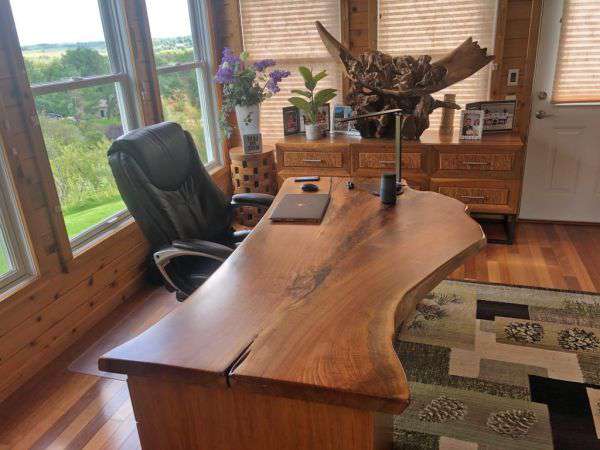Timber Desk Plans
Worktable Cabinet Schematics - Details To Remember When Making A Splendid Design

Of course it shouldn't be the first option and is dangerous if not used properly. The bookcases that flank the bed are optional. Then clamp or screw an auxiliary fence to saw's fence. Dust from lead-based paint is toxic, so you should not sand paint from the board. Access your classes anytime, anywhere-with a computer, tablet or smartphone. Then just add a finish and you've got a beautiful, useful gift. Even if you include a doghouse, provide other shaded areas (https://woodcraftdiagrams.com/diy-office-desk-plans-blueprints) in the kennel. The grain may look different, but that difference usually isn't noticeable in the dark toe space. Always stir polyurethane well before using-never shake it, as that could cause bubbles.
Flag problem areas with masking tape and sand them out. For painted shelves, fill holes with lightweight spackle, let it dry and sand it. Also nail intersecting corners of each frame piece. And you might be able to get doors free from yard sales or other sources. Find center of each bay and draw circular cutout for the blast gates with a compass. When a drawer is down, you have easy access to its contents. Press them onto form so they lie perfectly flat. Plane and sand craft edge to match factory-machined edge of the deck board. Start with 1x4s aligned with ends of the curved molding.
If this workbench looks familiar, it's probably because you've seen one a lot like it in your father's or grandfather's shop. The mats would cushion the top and keep it from sliding if you bump the file cabinets. (site link) When your lumber glue is completely dry, and you have checked that all wood slices are firmly secure to the plywood, prop your insert up and install in your fireplace. Get full plans for this kid-size workbench here. To frame the roof, install rafters. Take the frame apart, adjust the size if necessary, reassemble it using glue, and attach it to box.
Use a putty knife to spread it slightly beyond the edges of your template marks. Blind-corner cabinets-those with a blank face that allows another cabinet to butt into them-may be great for aging wine, but they're darn near impossible to see and reach into. Remove masking tape and clamp supports together on your workbench or in your vice. Secure trim pieces to posts with construction adhesive and galvanized finishing nails. This thing would hold a V-8 engine block. Sand corners flush and then rout the facing. To build this project, just craft lumber to length and screw the parts together.
To minimize potential cupping, we decided to make top by gluing two pieces of 1x6 together rather than using a solid board. First, nail the dentil assembly to the front of standards with 6d finish nails as shown in the photo above. Install door handles and magnetic catches to hold them closed. Draw centerlines on both sides, then glue and pin runner to bottom. The end of the lower rail was later hidden by the window seat. Evenly space back slats along the bottom brace. Drive dowel screws halfway into the bun feet. Be sure the front edges of cabinets are flush with each other before joining.
The biggest advantage to a prototype is that you and your family could test it for comfort. Available at hardware stores and home centers. Rout the inside perimeter of each door, moving router clockwise. Nail into the edge of the rafters with 10d casing nails. They may dictate where you place the standards. Then fasten it to the top slat with hinges. Because we varied the spaces between shelves, vertical back cleat lengths vary. Attaching the drawer front so it's perfectly aligned is a little tricky. Make guidelines on your tabletop with a permanent marker to help transfer the tile to top accurately.
This is one of the simplest furniture projects I've ever designed. Be sure to use a 40-tooth carbide blade for a smooth cut. An inexpensive turkey baster is a great tool for measuring small amounts of finish and mineral spirits. For a perfect edge, shave the overhangs with a flush-trim router bit. Sand up to line with a belt sander or sanding block. Then screw temporary X-braces to the posts. Let mortar set up until the next day. Luckily, scratches and stains can be easily sanded out and re-oiled and in a couple of months repair will darken as lumber oxidizes and disappear.
If the mixed grout stiffens before you could use it, stir it to restore the slushy consistency. Later you'll fill them with wood plugs to hide screws. Remove a knockout from top of box for the new cable. It could be difficult to store bikes both out of way and yet readily available. Mark arc with a pencil, then cut it out with a jigsaw. This can be a bit challenging, so make it easier by laying two nonskid rugs or mats on floor under chair frame and the top of back assembly.
